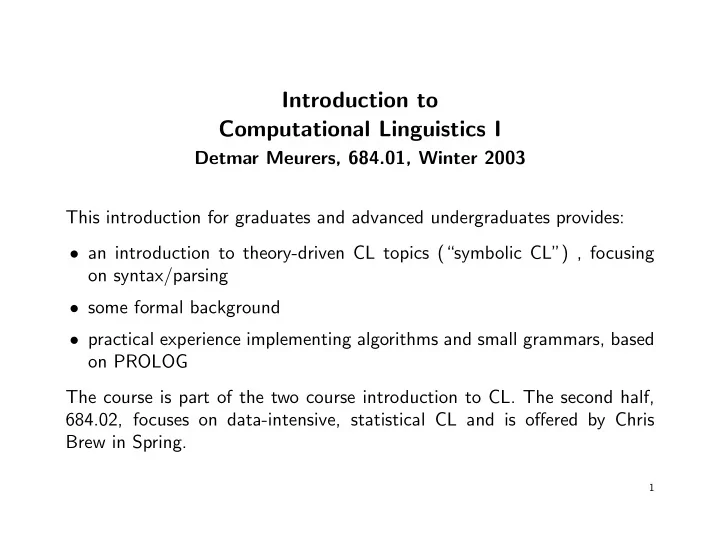

Introduction to Computational Linguistics I Detmar Meurers, 684.01, Winter 2003 This introduction for graduates and advanced undergraduates provides: • an introduction to theory-driven CL topics (“symbolic CL”) , focusing on syntax/parsing • some formal background • practical experience implementing algorithms and small grammars, based on PROLOG The course is part of the two course introduction to CL. The second half, 684.02, focuses on data-intensive, statistical CL and is offered by Chris Brew in Spring. 1
Organization (1) Class meets: Monday and Wednesday 9 30 –11 18 , 060 Derby Hall Course web page (overheads, etc.): http://ling.osu.edu/˜dm/03/winter/684.01/ Course participants email list: 684.01@ling.osu.edu Detmar’s office hours and office location: • Monday after class (11 30 –12 30 ), or by appointment • 201a Oxley Hall (tel. 292-0461) • Email: dm@ling.osu.edu 2
Organization (2) Course prerequisites: • Introduction to Syntax (LING 602.01 or equiv.) • Formal Foundations (LING 680 or equiv.) Successful course participation requires: • Regular attendance and active participation • Taking reading assignments serious and completing weekly homework assignments, some paper and pencil, some programming in Prolog (handed out Wednesday, returned Monday, discussed Wednesday). • Final project implementing a grammar fragment for a short (10 sentences) text of your choice, to be handed in Friday, March 14. 3
Course outline 1. Mon, 6. Jan. : Organization/Introduction 2. Wed, 8. Jan. : Finite state machines and regular languages 3. Mon, 13. Jan. : Implementing finite state machines in Prolog 4. Wed, 15. Jan. : More on Prolog (recursion, negation) and implementing 5. Mon, 20. Jan.: Martin Luther King Day 6. Wed, 22. Jan. : Towards more complex grammar formalisms: Basic formal language theory 7. Mon, 27. Jan. : From context free grammars to definite clause grammars 8. Wed, 29. Jan. : What to encode in a grammar: A DCG for English 9. Mon, 3. Feb. : How to process with a grammar: Intro to Parsing 10. Wed, 5. Feb. : Basic parsing strategies 11. Mon, 10. Feb. : More efficient parsing strategies 12. Wed, 12. Feb. : Remembering sub-results: Well-formed substring tables 5
13. Mon, 17. Feb. : Remembering subcomputations: The active chart 14. Wed, 19. Feb. : More complex data structures: From atomic symbols to first order terms to feature structures 15. Mon, 24. Feb. : Term and feature structure unification 16. Wed, 26. Feb. : Parsing with complex categories 17. Mon, 3. Feb. : Implementing a grammar in a typed feature structure based parsing system 18. Wed, 5. Mar. : 19. Mon, 10. Mar. : 20. Wed, 12. Mar. : Three aspects: • data structures • formalisms for expressing grammars using these data structures • parsing algorithms for processing with those grammars 6
Reading material A basic script as backbone to the material is on the course web page. General background reading material: • Gerald Gazdar and Chris Mellish (1989): Natural Language Processing in Prolog . Wokingham, England et al.: Addison-Wesley. • Fernando Pereira and Stuart Shieber (1987): Prolog and Natural- Language Analysis . Stanford: CSLI Publications. • Daniel Jurafsky and James H. Martin (2000): Speech and Language Processing . Upper Saddle River, NJ: : Prentice Hall. These books and other assigned reading material can be found in 201 Oxley. Reading assignment No. 1: Chapter 1 of Jurafsky & Martin (2000) 7
Recommend
More recommend